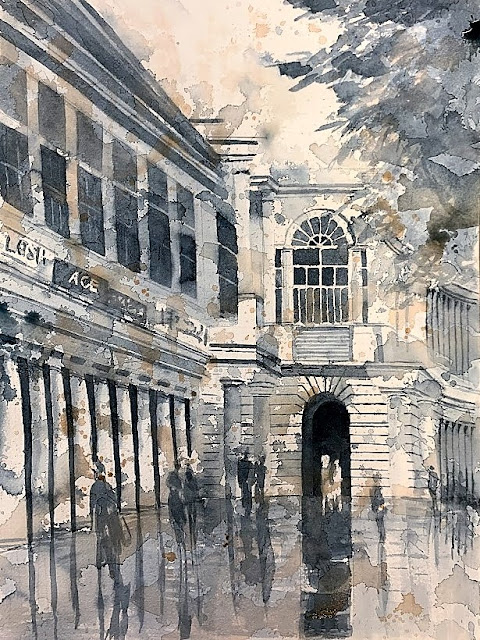Effects
Sometimes they can seem gimmicky, but if used right, and in moderation, effects are what make watercolors shine - they seem careless and imperfect, and that gives the watercolor its beauty. In her workshop, Jean Warren asked us to bring a painting that we would tear up (yes, I had to read that twice in her instructions!), rearrange the pieces together, but not to bring back the original painting, sometimes connecting whites, or similar values, or similar shapes, or any other ways to reconnect them - and use that as inspiration to create an abstract. I had a stack of paintings I was happy to tear up :-) or :-( ?
In fact, after I did tear one up, at the next paintsite, one of the regular attendees Brad told me how much he admired the painting I did last week, and how horrified he was when I told him flippantly that I just tore that up for a workshop. Just goes to tell you how art is SO subjective :-)
We did a lot of textures - using stamps, stencils, doilies, etc. in Jean's workshop, and I am mesmerized by textures and effects when they are used well in a painting. Shirley Trevena does this SO well - there is so much to SEE, and not a moment of boredom or somewhere where there is lack of interest in her paintings.
The best secret about abstract painting is that you are TRULY reacting to "what the painting needs", and not the wonky roof on the barn. You are reacting big picture to a shape here, needs some warmth there, needs some balance here - something we lose when we are painting "objects" that have meaning to us. One wonderful exercise, which I didn't really get at the time, was for us to set up our quarter sheets on our desk, and walk around to other people's workspaces, and make a random mark - a line or blob or splatter or anything, on each sheet as we walked around. After everyone had made their mark, we came back to our desks to find our sheet with 18 random marks on the paper. Now, we are truly reacting to those marks as we make a finished piece of abstract art out of them. The marks don't mean anything, but perhaps one looks like a petal, so around it, you might create a flower, then that is interacting with the next mark, and so on. You are truly seeing what's on the paper, and what you can make of it.
Here are the paintings I did in Jean's workshop. The main takeaways were - leave a white passage, think about corners (by not taking the paint to the edges or corners, you are, in effect, leaving a "white shape", intentional or not - THINK about that shape).
In fact, after I did tear one up, at the next paintsite, one of the regular attendees Brad told me how much he admired the painting I did last week, and how horrified he was when I told him flippantly that I just tore that up for a workshop. Just goes to tell you how art is SO subjective :-)
We did a lot of textures - using stamps, stencils, doilies, etc. in Jean's workshop, and I am mesmerized by textures and effects when they are used well in a painting. Shirley Trevena does this SO well - there is so much to SEE, and not a moment of boredom or somewhere where there is lack of interest in her paintings.
The best secret about abstract painting is that you are TRULY reacting to "what the painting needs", and not the wonky roof on the barn. You are reacting big picture to a shape here, needs some warmth there, needs some balance here - something we lose when we are painting "objects" that have meaning to us. One wonderful exercise, which I didn't really get at the time, was for us to set up our quarter sheets on our desk, and walk around to other people's workspaces, and make a random mark - a line or blob or splatter or anything, on each sheet as we walked around. After everyone had made their mark, we came back to our desks to find our sheet with 18 random marks on the paper. Now, we are truly reacting to those marks as we make a finished piece of abstract art out of them. The marks don't mean anything, but perhaps one looks like a petal, so around it, you might create a flower, then that is interacting with the next mark, and so on. You are truly seeing what's on the paper, and what you can make of it.
Here are the paintings I did in Jean's workshop. The main takeaways were - leave a white passage, think about corners (by not taking the paint to the edges or corners, you are, in effect, leaving a "white shape", intentional or not - THINK about that shape).
(composition started with random marks from others in the workshop!)
(composition from memory)
(one version from the pieces of the torn-up painting)
(another version from the pieces of the torn-up painting)
(composition from memory)










Comments
Post a Comment